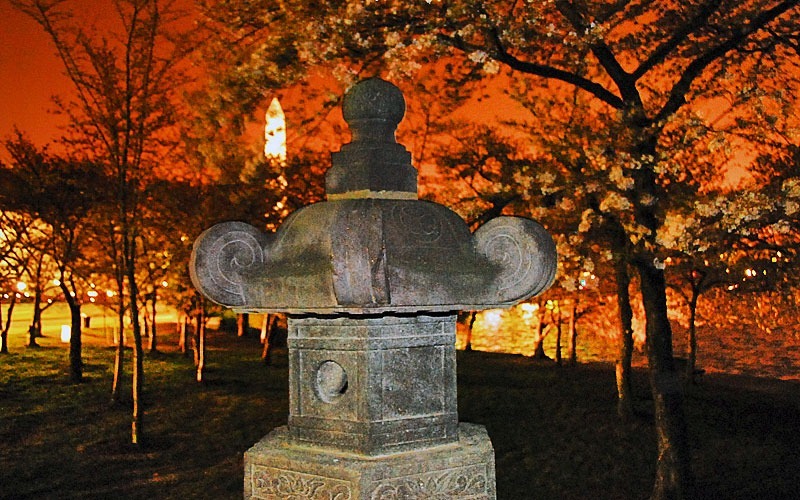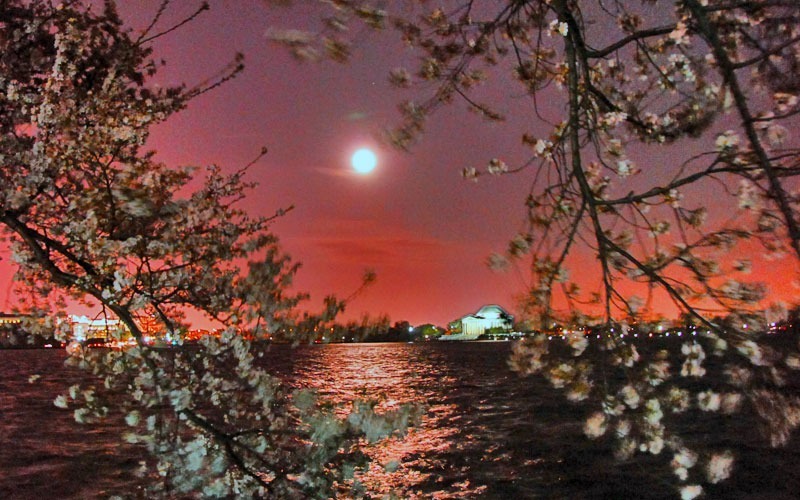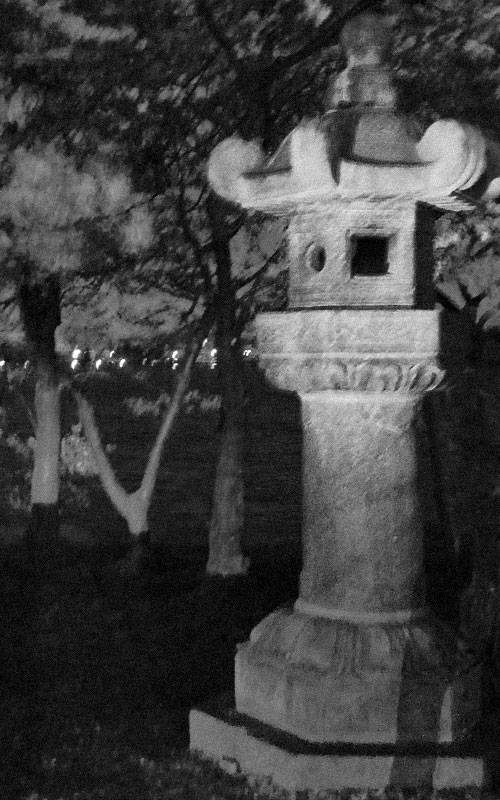Cherry blossoms, with their delicate pink and white petals, have long captivated the hearts and imaginations of people around the world. These iconic flowers hold a rich history deeply rooted in cultural significance and natural beauty. In this blog post, we’ll explore the fascinating history of cherry blossoms, their mesmerizing display at midnight at the DC Tidal Basin, and the art of night photography that captures their ethereal charm.

Midnight Cherry Blossoms
The Legacy of Cherry Blossoms
Cherry blossoms, known as “sakura” in Japanese, have been cherished in Japanese culture for centuries. The tradition of cherry blossom viewing, or “hanami,” dates back to ancient times and is celebrated as a symbol of renewal, beauty, and the fleeting nature of life. In 1912, Japan gifted thousands of cherry blossom trees to the United States as a gesture of friendship, and these trees were planted around the Tidal Basin in Washington, D.C., creating a stunning annual display that attracts millions of visitors.
Midnight at DC Tidal Basin: A Spectacle of Nature
The bloom of cherry blossoms at the DC Tidal Basin is a highly anticipated event each spring. As the cherry trees burst into bloom, the Tidal Basin transforms into a sea of pink and white flowers, creating a breathtaking panorama against the backdrop of the Washington Monument and other iconic landmarks. One of the most magical moments to experience this spectacle is at midnight when the moon casts a soft glow over the blossoms, enhancing their beauty and creating a dreamlike ambiance.

Capturing the Beauty: Night Photography Tips
Night photography presents a unique opportunity to capture the enchanting allure of cherry blossoms under the moonlit sky. Here are some tips for capturing stunning night photos at the DC Tidal Basin:
1. Use a Tripod: Stability is key for night photography. Use a sturdy tripod to keep your camera steady and prevent blurriness in long exposure shots.
2. Adjust Settings: Set your camera to manual mode and adjust settings such as ISO, aperture, and shutter speed for low-light conditions. Use a low ISO for minimal noise, a wide aperture (e.g., f/2.8 or lower) for depth of field, and a longer shutter speed (e.g., several seconds) for capturing ambient light.
3. Focus and Composition: Use manual focus to ensure sharpness, especially in dim light. Experiment with different compositions, angles, and focal points to highlight the cherry blossoms against the night sky or illuminated landmarks.
4. Long Exposures: Consider using long exposure techniques to capture the motion of flowing water in the Tidal Basin or create light trails from passing boats or vehicles. Use a remote shutter release or timer to avoid camera shake.
5. Experiment with White Balance: Play with white balance settings to achieve the desired color temperature and mood in your photos. Try warmer tones for a cozy, inviting feel or cooler tones for a serene, ethereal atmosphere.
Preserving a Timeless Beauty
As you immerse yourself in the history of cherry blossoms and embrace the magic of midnight at the DC Tidal Basin, remember that photography is not just about capturing images but preserving moments of fleeting beauty. Through the art of night photography, we can capture the timeless allure of cherry blossoms in bloom and share their ephemeral splendor with the world, keeping alive the legacy of these enchanting flowers for generations to come.
The History of Japanese Stone Lanterns: A Journey to the DC Tidal Basin
Japanese stone lanterns, with their timeless elegance and serene beauty, are not just decorative elements but symbols of cultural heritage and spiritual significance. As we delve into the history of these iconic lanterns, we’ll also embark on a virtual visit to the enchanting DC Tidal Basin, where these lanterns add a touch of Japan’s heritage to the blooming cherry blossoms each spring.
Origins and Symbolism of Japanese Stone Lanterns
Japanese stone lanterns, known as “ishidoro” in Japanese, have a rich history dating back centuries. Originally inspired by Chinese lantern designs, Japanese artisans refined and adapted the lanterns to suit their aesthetic and cultural sensibilities. Stone lanterns became integral elements of Japanese gardens, temples, and tea houses, symbolizing illumination, harmony with nature, and spiritual enlightenment.
Types of Japanese Stone Lanterns
There are several types of Japanese stone lanterns, each with its unique design and purpose:
1. Toro Lanterns: Toro lanterns are traditional Japanese garden lanterns characterized by their tiered structure and roof-like top. They come in various sizes and styles, from simple and rustic to elaborate and ornate, reflecting different architectural influences and historical periods.
2. Yukimi Lanterns: Yukimi lanterns, also known as “snow-viewing lanterns,” feature a wide, flat top designed to catch and showcase snowfall during winter. They evoke a sense of tranquility and seasonal beauty, often found in Japanese gardens and tea ceremony settings.
3. Tachi-Gata Lanterns: Tachi-gata lanterns have a tall, slender profile and are often used as pathway markers or focal points in garden landscapes. Their elegant silhouette adds a touch of sophistication and verticality to garden compositions.

Journey to the DC Tidal Basin: Cherry Blossoms and Stone Lanterns
The DC Tidal Basin, home to thousands of cherry blossom trees gifted by Japan, is a stunning backdrop for the enchanting beauty of Japanese stone lanterns. During the annual Cherry Blossom Festival, visitors can stroll along the Tidal Basin’s pathways, admiring the delicate pink and white blossoms against the serene waters, while Japanese stone lanterns dot the landscape, adding a sense of authenticity and cultural connection.
Exploring the Tidal Basin’s Stone Lanterns
As you explore the Tidal Basin, take a moment to appreciate the craftsmanship and symbolism of the Japanese stone lanterns. Notice the intricate carvings, weathered patina, and subtle play of light and shadow that enhance their timeless allure. These lanterns not only illuminate the pathways but also evoke a sense of harmony and contemplation amidst nature’s beauty.
Capturing the Moment: Photography Tips
Capture the essence of Japanese stone lanterns at the DC Tidal Basin with these photography tips:
1. Golden Hour: Opt for early morning or late afternoon light (golden hour) to capture warm, soft tones that complement the stone lanterns’ textures and hues.
2. Composition: Experiment with different angles and perspectives to highlight the lanterns against the cherry blossoms, water reflections, or architectural elements.
3. Long Exposure: Use long exposure techniques to create ethereal effects with moving water or passing clouds, adding a sense of motion and dynamism to your photos.
4. Detail Shots: Focus on the intricate details of the lanterns, such as carved motifs, textures, and play of light, to showcase their craftsmanship and beauty up close.
Embracing Cultural Heritage
As you immerse yourself in the history of Japanese stone lanterns and the enchanting beauty of the DC Tidal Basin, take a moment to reflect on the timeless appeal of these cultural treasures. Whether admiring their craftsmanship, capturing their essence through photography, or simply experiencing their tranquil presence, Japanese stone lanterns invite us to connect with nature, history, and the enduring legacy of artistic expression.
































